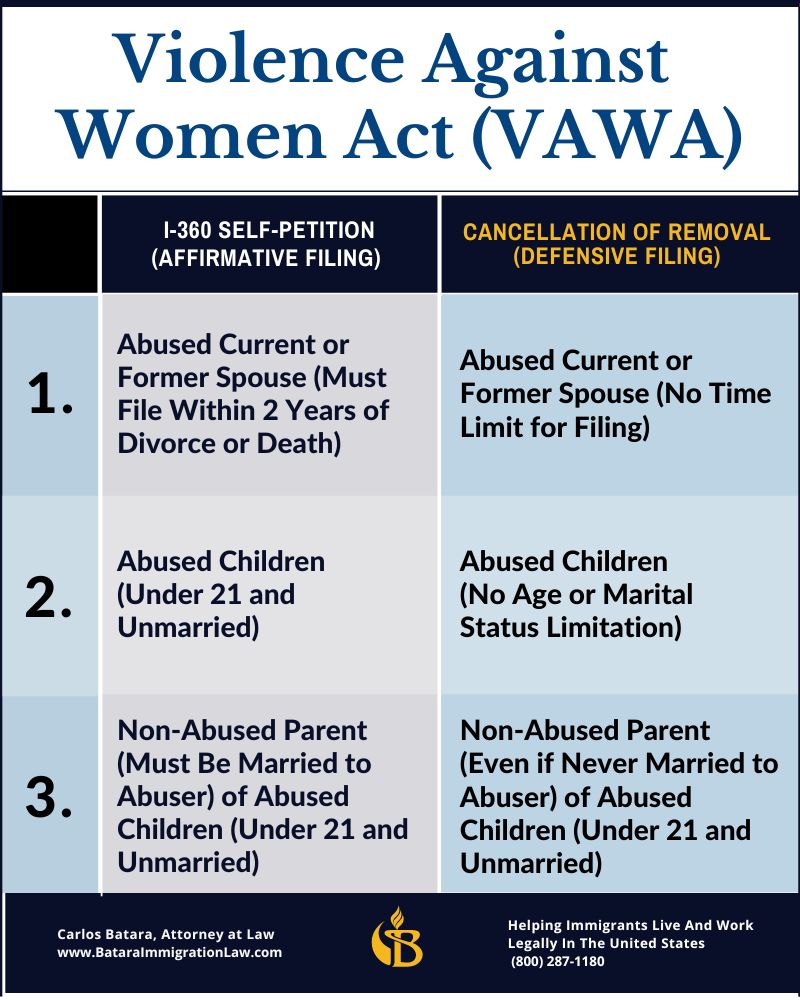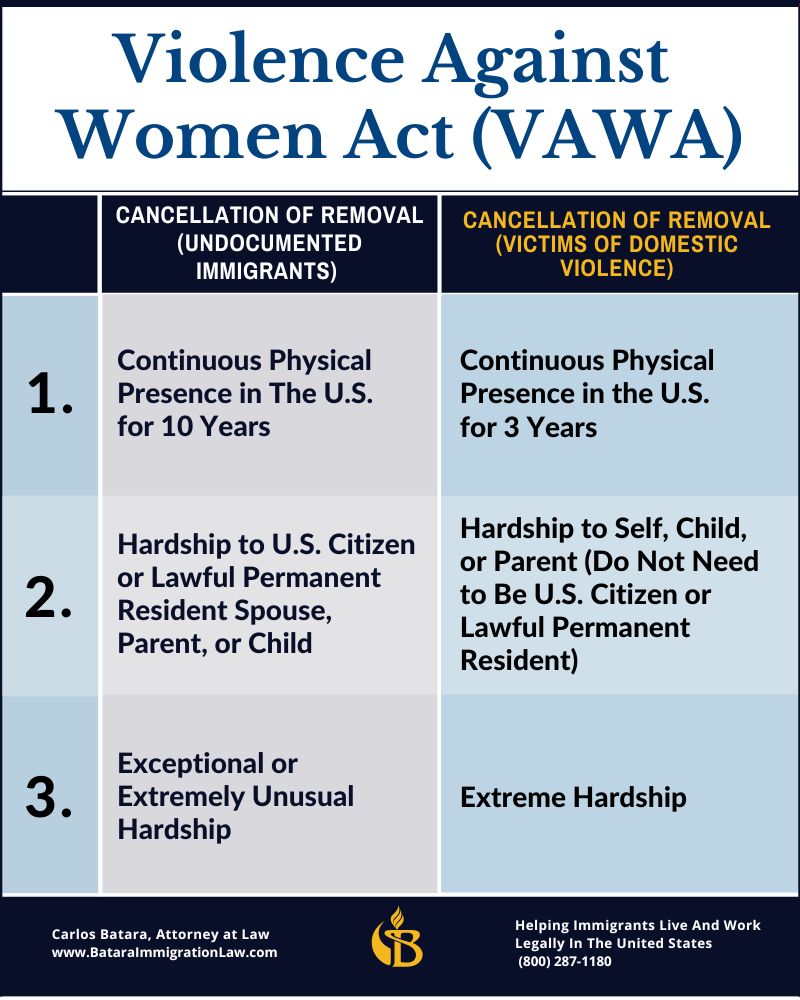
Battered and abused victims of domestic violence are often placed in immigration court proceedings to face deportation.
In most instances, their sole act of wrongdoing is based on living in the U.S. without permission.
Protection against their removal is in plain view.
Yet, the issue is missed.
In this article, we’re going to discuss why this happens, and what you must know to prevent such miscues from happening to you.
Table Of Contents
- Can The Violence Against Women Act Protect Immigrants From Deportation?
- What Is The Difference Between Affirmative And Defensive VAWA Filings?
- VAWA Self-Petitions vs VAWA Cancellation Of Removal
- Abused Spouses: Two-Year Filing Limit
- Abused Immigrant Children
- Non-Abused Immigrant Parents Of Abused Immigrant Children
- Cancellation Of Removal vs VAWA Cancellation Of Removal
- Continuous Physical Presence In U.S.
- Whose Hardship Counts In VAWA Cancellation Cases?
- What Is Hardship In VAWA Cancellation Cases?
- Conclusion
Can The Violence Against Women Act Protect Immigrants From Deportation?
Take Nancy. She had testified about how her spouse, a U.S. citizen, stalked her after their separation.
She had endured years of abuse before she left him, moving back to her parents’ home.
One day, her spouse forcibly tried to remove their children from her parents’ home. When her 75-year old father asked him to calm down, he went into a deeper rage.
He grabbed Nancy’s father from behind and started choking him. He put a gun to her father’s head.
Neighbors, hearing the commotion, called the police. When they arrived, they told him to put the gun down. He would not and his threats became louder. Just as it seemed he was about to pull the trigger, the police shot first.
Despite such testimony, Nancy’s attorney never raised the Violence Against Women Act as a defense.
She contacted us to inquire whether we could help with her immigration appeal at the Ninth Circuit.
She has already lost her immigration court and BIA appeals cases. She had hired three attorneys already. That she had switched attorneys so often was not a positive sign.
After a long, long discussion, I agreed to help her.
Two days later, she returned with 1,600 pages of court documents.
Over the weekend, I reviewed her file and court transcripts. Various issues stood out. In particular, all three lawyers failed to raise the Violence Against Women Act (VAWA) as a defense against removal.
What Is The Difference Between Affirmative And Defensive VAWA Filings?
In general, there are two roads to protection against abuse and access to immigration benefits under VAWA.
Affirmative VAWA Filings (VAWA Self-Petitions)
The first road, more commonly known, is considered an “affirmative” filing. You are submitting a self-petition, Form I-360, to the USCIS service center which reviews such applications.
Affirmative filings are “affirmative” because they are by immigrants who are not in immigration court proceedings facing deportation. They are pro-actively seeking a change of immigration status based on their VAWA self-petition.
The filing is deemed a self-petition. Unlike most immigration petitions, there is no need for a family member or employer to sponsor you. A self-petition, in other words, means you are filing on your own.
Defensive VAWA Filings (VAWA Cancellation)
The second road is called a “defensive” filing. In these situations, the immigrant is facing deportation from the United States. The Violence Against Women Act is raised as a defense against removal.
This requires filing Form EOIR 42-B, Application For Cancellation Of Removal And Adjustment Of Status, with the immigration court.
Note: This article does not cover a third (hybrid) use of VAWA for immigrant spouses who need to remove the conditions on their green cards after two years of marriage. See here for more information on that topic: Abandoned Fiancées And Spouses: How To Remove Conditions
Unfortunately, it is not uncommon for immigrant attorneys and government lawyers to miss domestic violence as a defense. This is due, in part, to confusion about how the rules for VAWA self-petition affirmative filings differ from the rules for VAWA cancellation of removal defensive filings.
Just about a month after the VAWA immigration legislation went into effect, I recall a case in which opposing counsel became irate with the judge for letting me present my client’s VAWA-based deportation defense.
He asserted that she had been divorced six years, more than the two year limit on VAWA filings; that she had not been continuously present in the U.S. for 10 years, as required for cancellation of removal; and that she lacked qualifying relatives who would suffer hardship if she were deported.
He was wrong on all three points. He did not understand how the VAWA Cancellation of Removal rules are different from the rules for VAWA self-petitions.
Let’s explore these differences.
VAWA Self-Petitions vs
VAWA Cancellation Of Removal
Using VAWA at immigration court has three major differences from filing for a self-petition under the Violence Against Woman Act program.

Abused Spouses: Two-Year Filing Limit
A VAWA self-petition must be filed within two years of the date of divorce or date of the death of the immigrant’s spouse. In immigration court, there is no two year filing limit.
If an immigrant has filed an I-360 self-petition that is denied by USCIS, he or she can still raise VAWA as a defense at court even if 5 or 10 years have passed since the date of divorce.
In some cases, after a self-petition is denied, an applicant will receive a Notice To Appear at immigration court to face removal charges.
Nonetheless, even if the I-360 was denied specifically because it was filed more than two years subsequent to divorce, it is okay to raise VAWA Cancellation as a defense because there is no two-year limit at such hearings.
(However, as the Board of Immigration Appeals made clear in Matter Of L-L-P-, the abuser must have been a U.S. citizen or lawful permanent resident at the time of the abuse – a rule that applies to all I-360 petitions and VAWA Cancellation.)
Abused Immigrant Children
If an abused child seeks protection under VAWA affirmatively because a lawful permanent resident or U.S. citizen parent has abused them, the I-360 has to be filed before their 21st birthday. In addition, the applicant must be unmarried.
On the other hand, if you are in immigration court proceedings and you were abused as a child many years ago, you can still qualify for VAWA Cancellation Of Removal. This is true even if you are now both married and over 21.
Non-Abused Immigrant Parents
Of Abused Immigrant Children
Here is a third point of variance you should know.
If you are a non-abused parent – who has not been personally harmed by your spouse – but your child has been abused, you could claim VAWA benefits under a self-petition.
At the time of filing, the child has to be under 21 and unmarried for the immigrant parent to submit an I-360 self-petition based on the abuse to the child.
At immigration court, a non-abused immigrant parent of an abused immigrant child can file for VAWA Cancellation of Removal. As with an I-360 self-petition, the child must be under 21 and unmarried in order for the non-abused parent to qualify.
One major differentiation at immigration court is that the non-abused immigrant parent is not required to have married the abuser.
This means that even if the immigrant parent never married and never suffered abuse at the hands of the U.S. citizen or permanent resident parent, he or she can seek VAWA Cancellation at immigration court.
(Of course, in most cases where a child has been abused by a U.S. citizen or permanent resident parent, the immigrant parent has likely suffered, at minimum, some psychological abuse and been the victim of extreme cruelty that might support an independent I-360 self-petition claim.)
Cancellation Of Removal vs
VAWA Cancellation Of Removal
VAWA at Immigration Court falls under the regulations for Cancellation of Removal. As a result, errors are sometimes made because the rules for VAWA Cancellation diverges from those set forth for other forms of Cancellation of Removal.
Let’s dive back in.
To begin, Cancellation of Removal is a form of immigration defense that allows immigrants who are facing deportation to retain or win permanent resident status.
There are three types of Cancellation of Removal.
Cancellation Of Removal For Permanent Residents
One is for immigrants who are already permanent residents. This type of Cancellation of Removal is found under INA section 240A(a). Often referred to as 42A Cancellation, this is not the type of Cancellation of Removal we are discussing here.
Cancellation Of Removal For Non-Permanent Residents
Two other types of Cancellation of Removal are available for undocumented immigrants, those who entered the U.S. without permission or who overstayed their temporary visas.
These two types of Cancellation of Removal are our focus in this article.
Here are the two types of Cancellation provisions for undocumented immigrants that we will compare:
Under 240(b)(1), one type of Cancellation of Removal is available for all non-permanent residents who can meet its requirements. This is commonly called 42B Cancellation.
A second type applies only to undocumented immigrants who were battered or abused by a U.S. citizen or permanent resident. This form of Cancellation of Removal can be found at INA 240A(b)(2). It is typically referred to as VAWA Cancellation.

There are three main distinctions between 42B Cancellation and VAWA Cancellation.
Continuous Physical Presence In U.S.
Under 240B Cancellation of Removal, an immigrant must prove they have resided in the United States for 10 continuous years before filing their application in immigration court.
Under VAWA Cancellation of Removal, the immigrant is only required to demonstrate three years of continuous physical presence.
(In addition, there is an exception to this requirement if the immigrant defendant was forced to leave the country and their action was connected to the abuse.)
Whose Hardship Counts In
VAWA Cancellation Cases?
Under Cancellation of Removal for non-permanent residents, the immigrant who is facing deportation must prove his or her removal will cause an exceptional or extremely unusual hardship to a qualifying relative.
Who are qualifying relatives?
A United States citizen or lawful permanent resident, spouse, child, or parent.
This means, under 42B Cancellation, the immigrant is not considered a qualifying relative and their personal hardship is not directly relevant to the court’s adjudication.
On the contrary, under VAWA Cancellation, hardship to the abused immigrant is directly relevant.
Under VAWA Cancellation, the qualifying relatives are a parent, a child, as well as the immigrant. themselves.
Unlike 42B Cancellation of Removal, immigration courts are mandated to consider direct evidence of hardship personally incurred by an immigrant in VAWA Cancellation hearings.
On the other hand, hardship to an immigrant’s spouse is taken out of the equation. This makes 100% sense. Since the U.S. or permanent residence spouse is the abuser, their hardship is irrelevant to an immigrant trying to escape victimization and mistreatment.
(Editor’s Note: Although the immigrant facing deportation is not a qualifying relative in 42B cases, his or her suffering can sometimes count as an indirect hardship to one of the three qualifying relatives in such matters. This is a issue immigrants and their representatives should be careful not to overlook.)
What Is Hardship In
VAWA Cancellation Cases?
The third difference between VAWA Cancellation and 42B Cancellation is the standard of hardship evidence that must be shown.
As noted above, under 42B Cancellation of Removal, the standard is exceptional and extremely unusual hardship.
Under VAWA Cancellation, it is extreme hardship.
Immigration courts have repeatedly asserted exceptional and extremely unusual hardship is a more difficult standard.
(Personally, I think the distinction between the two standards, if it exists at all, is relatively minor. Both standards are stringent, regarding strong proof of potential harm to qualifying relatives.)
In any event, what truly separates hardship under a VAWA Cancellation approach from a 42B Cancellation approach is that the former category has not one, but two unmistakable components.
First, there is the suffering that emanates from typical 42B hardship factors like loss of family ties, health issues, and financial instability.
Second, unlike 42B Cancellation, there is the hardship which arises from battery, extreme cruelty, and abuse.
In short, 42B Cancellation is built around family unity, trying to prevent the separation of family members. VAWA Cancellation, on the other hand, pertains to families already torn apart.
This duality of evidence in VAWA Cancellation cases dictates two separate, though overlapping, types of evidence which should be compiled by abused immigrants at immigration court.
The combination of evidence showing how domestic violence has been harmful to the victims – coupled with how removal would impede any progress made to overcome the effects of such abuse – is crucial to ensure the standard of extreme hardship for VAWA Cancellation is met.
Here are a few examples:
- Affidavits and sworn statements from family members, friends, co-workers, social workers, and psychologists regarding the abuse you or your children have experienced.
- Documents and records like police reports, court filings, civil protective orders.
- Letters and copies of health, medical, and counseling records pertaining to the abuse suffered.
- Information that shows how you, your children, and other qualifying relatives would suffer if you were removed from the United States. This often includes letters from the children’s teachers, coaches, and mentors describing their “Americanization, integration into the community, and involvement in extra-curricular activities.
- Similarly, verified statements from co-workers, church friends, and neighbors illustrating the immigrant’s contributions also help demonstrate 42B type of hardships.
In summary, when it comes to proving hardship, VAWA Cancellation applicants have the advantage of utilizing not only a lower evidentiary threshold, but also a broader range of factors than 42B Cancellation applicants.
Conclusion
Many abused immigrants, once taken into immigration custody, despair and are inclined to forfeit their dreams of becoming permanent residents.
To them, having to face deportation charges, after being stuck in an abusive relationship for several years, is the emotional equivalent of pouring salt on an open wound.
Adding insult to injury, the possibility of removal heightens internal feelings of rejection and often unworthiness.
Yet, there is a potential silver lining to their history. At immigration court, they can use both domestic violence and non-domestic violence evidence to support applications to cancel their deportations and win green cards.
As noted above, filing for VAWA protection at immigration court provides applicants more leeway than a self-petition under the Violence Against Women Act or a 42B application for Cancellation of Removal.
Plain and simple, VAWA Cancellation is a defense against deportation for victims of domestic abuse that should never be missed.
Ready to take a serious and honest look at the strengths and weaknesses of your immigration case? Let’s get started with a personalized strategy and planning session . . .




